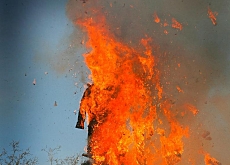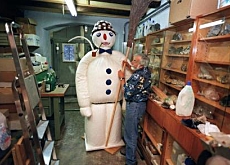Snowman’s fiery death announces warm summer

Zurich has rung in the spring with its traditional Sechseläuten (six bells) festivities, culminating with the symbolic burning of the Böögg snowman.
The cotton effigy almost didn’t make it to the festivities, after a group of leftwing militants stole the original Böögg from a garage last week.
It only took just under ten minutes and 30 seconds for the snowman’s head – loaded with explosives – to blow up on Monday, announcing a warm summer.
According to tradition, the less time it takes for the explosion to happen, the better summer will be. Over the past ten years, the average time for the Böögg to explode has been 14 minutes.
In 2003, the snowman accurately predicted the summer heat wave, but on other occasions the result has been well off the mark.
The pyre was lit at six o’clock by the president of canton Aargau’s government, Kurt Wernli, and Swiss Finance Minister Hans-Rudolf Merz.
Tens of thousands of spectators were on hand to follow the symbolic execution of winter. Beforehand, members of Zurich’s 26 guilds paraded through the old town in period costume.
Political action
A group of leftwing militants stole the original giant cotton snowman in the early hours of last Wednesday morning.
They smashed a window of the garage where it was stored, leaving a chocolate Easter bunny and a hammer and sickle emblem in its place. Police confirmed on Sunday that the snowman was still missing.
The group, calling itself the “1. Mai – Strasse Frei” (loosely translated as Retaking the Streets on May Day), claiming responsibility for the theft, saying the 3.5-metre tall snowman “had had enough of putting its head on the line for capitalists”.
The Böögg was still not assembled when most of it was stolen. Police said the thieves did not manage to cart away the 100-kilogram neck or the main charge.
The snowman had never been stolen before, although plans had been drawn up to nab him during student unrest in the 1980s. Police were able to avert the theft at the last minute thanks to a tip off.
A stand-in was used on Monday.
Tradition
The Sechseläuten festival in its current form dates back to 1867.
It derives its name from the fact that at the spring equinox the bells of Zurich’s main cathedral would toll vespers again at six o’clock to announce the end of the working day.
In winter time the working day lasted only until five o’clock due to early dusk.
swissinfo with agencies
Sechseläuten is run by Zurich’s guilds.
The city’s guilds are run as private social clubs with a total membership of around 3,500.
The earliest guilds were founded in 1336 and played a key role in Zurich life for more than 500 years.
They began to lose their economic influence in the 1830s.

In compliance with the JTI standards
More: SWI swissinfo.ch certified by the Journalism Trust Initiative

You can find an overview of ongoing debates with our journalists here. Please join us!
If you want to start a conversation about a topic raised in this article or want to report factual errors, email us at english@swissinfo.ch.